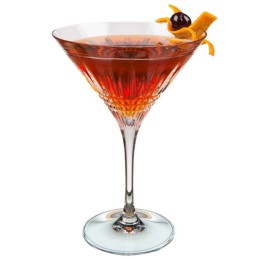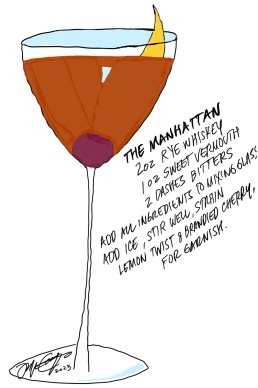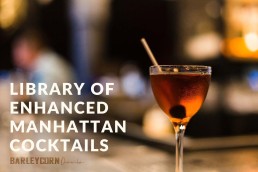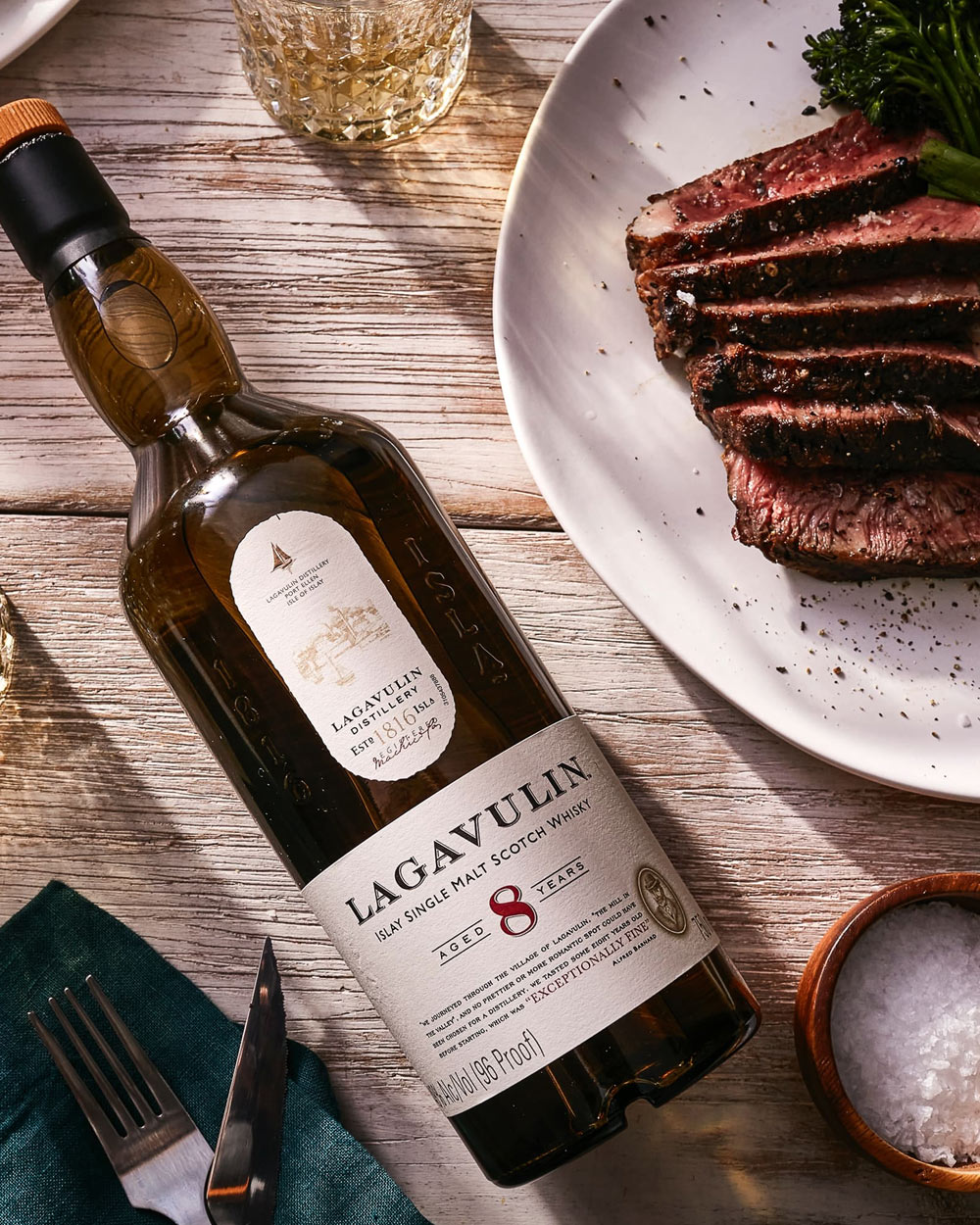The now classic Manhattan cocktail is a classic for a reason.
Simply prepared but wonderfully complex, this time-honored drink shares status with the Martini and Old Fashioned as a gateway to serious home bartending and a sign of the maturation of one’s personal palate. It is also a cocktail that takes well to spin-offs.
I believe that the best Manhattan is made with a rye whiskey base. The higher the proof, the better. Bourbon works fine; just be sure to use a strong one, as it helps the naturally sweeter whiskey stand up to the vermouth and bitters. I’ve been landing on a Bourbon base for any variant with dry vermouth; it pairs more naturally than a sweet Italian style.

New Yorkers should be proud of the Manhattan cocktail. After all, it is a New York City creation. It is also one of the first drink recipes to soften the original Cocktail by tempering it with vermouth and, by doing so, ensuring its longevity both historically and as a nightly tipple. Like most first editions of these cocktails, the vermouth was added in equal portion to the base spirit. I prefer the 2:1 base spirit to vermouth ratio, but raising the spirit portion up half an ounce is fine, especially when using full-flavored vermouth such as Punt e Mes.
As for the bitters, I like variety here. Aromatic bitters are my choice in the winter months, whereas I prefer the orange variety for a pre-dinner drink on a warm evening. Yes, you will notice a difference. You can even use both. I won’t tell. As with the Old-Fashioned, just by altering the bitters, you can enjoy a slightly different cocktail every day. Be adventurous.
Much has been made over the final garnish of a proper Manhattan, so I will just say this: Life is short—go for broke and twist a lemon peel over the drink and drop a brandied cherry in it (I prefer orange peel if using bourbon).
“New Yorkers should be proud of the Manhattan cocktail. After all, it is a New York City creation.”
What You’ll Need
2 oz. Rittenhouse Bottled in Bond Rye Whiskey
1 oz. Noilly Prat Sweet Vermouth
2 dashes Angostura Bitters
How To Make It
Add all ingredients to a mixing glass. Add ice and stir well. Strain into a cocktail glass. Expressed lemon peel and brandied cherry for garnish.

Riffing On A Classic
As a general starting point when enhancing the Manhattan, I would go with the 2:1-ounce template of whiskey to vermouth. If I add one ingredient, a third to half an ounce will do. For a two-addition twist, a quarter ounce of each would be an excellent place to start. Of course, absinthe should be treated as bitters and added only a dash or two at once. As for the vermouth in a standard recipe, I typically lean on something fuller in flavor, such as Cinzano. However, Noilly Prat or Martini & Rossi make for a better enhancement palette. That said, you can adjust all variations below from this template.

Library Of Enhanced Manhattan Cocktails: Standard Variations
When a variation has multiple drink titles, I did not include every known name for said Cocktail, just the ones primarily used in this century.
Bensonhurst: Maraschino and Cynar enhancements
Blackthorn or Emerald: Irish whiskey based
Bobby Burns: Scotch based with Benedictine enhancement
Brooklyn: Dry (or traditionally sweet) vermouth with Maraschino and amaro enhancements
Brooklyn Heights: Dry vermouth, Maraschino, and Meletti amaro enhanced with Campari rinsed glass
Bushwick: Lucano Amaro and Maraschino enhanced
Carrol Gardens: Nardini Amaro and Maraschino enhanced
Creole: Rye based with Amer Picon (or amaro) and Benedictine enhancements
Dry Manhattan: Dry Vermouth
Fanciulli: Fernet Branca enhanced
Fourth Regiment: Uses Celery, Orange, and Peychaud’s bitters
Greenpoint: Yellow Chartreuse enhancement
Liberal: Amer or China-China enhanced
Little Italy: Cynar enhancement
Marconi Wireless or Star: Applejack based
Martini (Original): Old Tom Gin based, paired with sweet vermouth
Martinez: Genever, Old Tom, or London Dry Gin based, paired with Sweet Vermouth and Maraschino enhancement
Metropole: Cognac based with dry vermouth and Peychaud’s bitters
Metropolitan: Cognac based
Palmetto or Cuban Manhattan: Rum based
Perfect Manhattan: Split of Sweet and Dry Vermouth
Red Hook: Punt e Mes vermouth and Maraschino enhancement
Remember The Maine / McKinley’s Delight: Cherry Heering and absinthe enhancements
Rob Roy: Scotch based
Robert Burns: Scotch based with absinthe enhancement
Saratoga: Equal parts rye, bourbon, sweet vermouth
Sombrero: Perfect Manhattan with Reposado or Anejo base
A Tale of Two Roberts: Benedictine and absinthe enhanced
The Slope: Apricot liqueur enhanced
Sunset Park: Dry vermouth and Apricot
Vieux Carré: Split base of Rye and Cognac with Benedictine enhancement
Waldorf: Rye-based, absinthe enhanced
When A Manhattan Isn’t Really A Manhattan
I also maintain that, like the Martini, vermouth is its defining ingredient. That’s why I’m not including variants that substitute amaro or other liqueurs in the vermouth slot or ramp up the enhancing component past a half ounce, as this also detracts from its Manhattan foundations. Here are examples.
Algonquin: The pineapple juice is a full ingredient, not an enhancement.
Black Manhattan, Ce Soir, and Toronto: These drinks replace vermouth altogether with Amaro, Cynar and Yellow Chartreuse, and Fernet, respectively.
Cobble Hill: Includes muddled cucumber and dry vermouth with Montenegro amaro enhancement. The cucumber is a step too far from the template for me.
Harvard: Cognac based but topped with Club Soda or sometimes Champagne. The bubbles are too far away from NYC and too close to Cambridge.
La Louisiane: Benedictine is a full ingredient, not an enhancement.
Enhanced Manhattan Recipes
Enhancing or improving a cocktail by adding a touch of liqueur has been around as long as Cocktail themselves (Maraschino and Orange Curacao are the original culprits going back at least to the mid-1800s). In fact, the addition and popularity of oddball ingredients to the standard Cocktail ultimately led to the ‘Old Fashioned’ Cocktail in the late 1800s, in that it was ‘Old Fashioned’ because it did not contain any enhancements. Here are a few I’ve recently created.
Theater District Manhattan (2021)
In the early spring of 2021, just as Covid vaccinations were getting easier to come by and New York City was slowly coming back, I was asked by Highgate Hotels to consult on the launch of M Social Times Square in New York. Leaning on a ‘primarily local’ concept in food and beverage, I wanted to incorporate as many local products as possible. Not only did I intend to impress future hotel guests with the highest level of quality in New York, but also to support local businesses after struggling to keep their operations running. It was a successful plan, and I was excited to have some fun with a Times Square property that included a large outdoor deck with multiple event spaces.
Quickly becoming the unofficial signature cocktail of the Beast & Butterflies Lobby Bar at M Social, the ‘Theater District Manhattan’ was a guest favorite upon opening. This Cocktail takes a classic Manhattan to a new level using Ragtime Rye from New York Distilling Co. and Greenhook Ginsmiths Beach Plum Liqueur. Both ingredients were made in the Brooklyn neighborhood where I was born and live today, and the beach plums used in the maceration process of the gin came from Queens and Long Island beaches.
What You’ll Need
2 oz. Ragtime Rye
1 oz. Noilly Prat Sweet Vermouth
½ oz. Greenhook Ginsmiths Beach Plum Gin Liqueur
2 dashes or 1/8 oz. simple syrup
1 dash Regan’s Orange Bitters
How To Make It
Combine ingredients in a mixing glass. Add ice and stir well. Strain into a chilled cocktail glass. Garnish with expressed orange peel and brandied cherry.
Waldorf 90 (2022)
I was then asked by The Waldorf Astoria Towers, here in NYC, to craft a cocktail to commemorate the hotel’s 90th anniversary of the Park Avenue location. Having been credited with creating more than a few renowned cocktails in its day, I thought I would take a swing at modernizing its classic ‘Rob Roy’ or, more specifically, its ‘Robert Burns cocktail. The Waldorf Astoria rendition of ‘Robert Burns’ is simply an absinthe-enhanced ‘Rob Roy.’ The more popular ‘Savoy’ version is Benedictine enhanced. When I managed Peacock Alley, I combined the two elements for a new twist on these classic cocktails. I called that ‘A Tale of Two Roberts.’ The ‘Waldorf 90’ incorporates the new, fruit-forward Bombay Bramble berry-flavored gin, which pairs nicely with Highland and Speyside Scotch whiskies.
What You’ll Need
2 oz. Aberfeldy 12-Year-Old Scotch Whisky
1 oz. Martini & Rossi Sweet Vermouth
½ oz. Bombay Bramble Blackberry & Raspberry Flavored Gin
2 dashes or 1/8 oz. simple syrup
2 dashes Regan’s Orange Bitters
How To Make It
Add all ingredients to the mixing glass. Add ice and stir well. Strain into a chilled cocktail glass. Expressed orange peel and brandied cherry for garnish.
Sloe Down Manhattan (2022)
In the spring of 2022, Ford’s Gin released their new Sloe Gin expression, just in time for a corporate event I was to host, which requested that I provide some fun twists on classic cocktails. You don’t have to ask me twice. I leaned on lighter vermouths in all these iterations as I wanted the enhancement ingredients to shine. Adding a touch of syrup is both in line with pre-prohibition protocols and serves a purpose. Remember, these are legitimate flavored gins and not liqueurs, so the tannin and grip of the correlating fruits are all included, and the syrup balances these natural elements. You can experiment if you don’t believe me.
What You’ll Need
2 oz. Old Forester Bottled in Bond Straight Bourbon
1 oz. Noilly Prat Sweet Vermouth
½ oz. Ford’s Sloe Gin
2 dashes or 1/8 oz. simple syrup
2 dashes Regan’s Orange Bitters
How To Make It
Add all ingredients to a mixing glass. Add ice and stir well. Strain into a cocktail glass. Expressed orange peel and brandied cherry for garnish.
The through-line with these three variations is, of course, flavored gin as the modifying element. It is just serendipity that I incorporated three relatively new gin-related items into the marketplace and found them a home in a century-and-a-half-year-old recipe.
Here’s to some new favorites. See you around Manhattan.
Frank Caiafa is an author, writer, tasting judge, and food and beverage director/consultant who has worked with some of the world’s top bars and restaurants including New York’s Lexington Hotel and Waldorf Astoria. Frank is the author of The Waldorf Astoria Bar Book, a modern update of the classic cocktail books of the Waldorf from the 1930s. His writing and recipes have been published in numerous publications including The New York Times, Wine Enthusiast, and Time Out New York.


